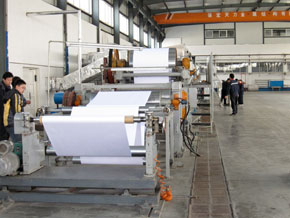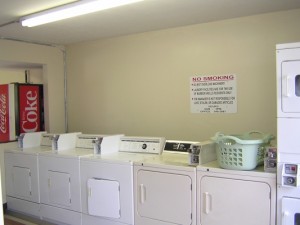As you may know, my favorite metric for evaluation a company is its ability to generate free cash flows. However, it is dangerous to focus entirely on that issue to the exclusion of other important aspects of a company. I will explore this issue by examining Lodgenet (LNET), a company with free cash flow through the roof, but with certain offsetting characteristics that make it an unattractive prospect to me.
 Lodgenet’s business is providing media and connectivity on demand in hotels, and they are also expanding into hospitals. The majority of the company’s revenue comes from guest on-demand movies, including what are described in the SEC filings artfully describe as “independent films, most of which are non-rated and intended for mature audiences”. Lodgnenet also provides ordinary cable programming and broadband Internet service, which it supplements with advertisements.
Lodgenet’s business is providing media and connectivity on demand in hotels, and they are also expanding into hospitals. The majority of the company’s revenue comes from guest on-demand movies, including what are described in the SEC filings artfully describe as “independent films, most of which are non-rated and intended for mature audiences”. Lodgnenet also provides ordinary cable programming and broadband Internet service, which it supplements with advertisements.
The company’s numbers are phenomenal; in 2010 the firm’s free cash flows were $50 million, although because much of that comes from excess depreciation, the firm’s earnings power would be about $32 million if excess depreciation was taxed. Lodgenet has 10% preferred stock outstanding, which has a prior claim of nearly $6 million per year, and I shall have more to say about the preferred stock later. Even so, the company’s market cap is only $90 million, so depending on which tax treatment is chosen, the company has a free cash flow yield of 30.3% under the high tax scenario, or 48.9% under the low tax scenario. In other words, in a little over three years, based on current earnings power, Lodgenet would earn a purchaser enough in free cash flow to pay off the shares.
But could it, really? I am concerned that this may be too good to be true. Lodgenet’s sales have been declining for some time, and the firm has a massive debt position that raises concerns about interest coverage and covenant compliance. The preferred stock that I mentioned was issued in June of 2009 in order to equitize a portion of Lodgenet’s debt (as well as provide some anti-takeover provisions) and there was a stock offering in 2010 that had the same effect, although the firm claims that part of the proceeds were used for capital spending as well. In the first quarter of 2011 Lodgenet also refinanced its debt agreement, expanding its permitted leverage ratio from 3.5 to 4 and reducing its interest coverage ratio from 3x to 2.25x in exchange for an increase in interest rates, which are estimated to be 6.5% (5% plus LIBOR, or plus 1.5%, whichever is higher) on a forward-looking basis, apart from a brief spike next quarter before Lodgenet’s swaps expire.
Furthermore, 2010’s capital expenditures, at $22 million, are well below the five-year average levels of $47 million. Now, as is stated in Benjamin Graham’s Security Analysis, a company can only be said to have earned money if it has made sufficient capital expenditures to maintain its earnings power. Damodaran, in his useful toolkit Damodaran on Valuation, reminds us that there can be a distinction drawn between maintenance and growth capital expenditures, with the latter having a sort of optionality attached to it. However, most corporations do not divide the two types of capital expenditures in their reports, and even if they did, the companies have a vested interest in making the growth category as large as possible, both because it makes free cash flows look better and because investors like growth. And of course, it is a distinction without a difference in many cases, as the money is spent either way. Therefore, the wise approach is to take the conservative view that all capital spending is maintenance capital spending.
However, owing to the declines in Lodgenet’s sales and operating cash flows, we do not have this luxury of choice; it is clear that levels of capital spending are below replacement levels, as the lower than average capital expenditures for the last few years may indicate, as would the lowered amounts of actual hotel rooms serviced (1.8 million as of the first quarter 2011 as compared to 1.98 million in 2008). It may be that, like Mac-Gray, Lodgenet is shedding its lower-margin clients, and indeed Lodgenet is focusing on expanding its high-definition offerings, but that too may require more capital than current spending would indicate.
 So, enough of dancing around the figures; let us examine them. In 2010 sales were $452 million and reported operating earnings were $23 million. Depreciation was $83 million and capital expenditures were $22 million. This produces excess depreciation of $61 million, which makes operating cash flow $84 million. Interest expense that year was $34 million, leaving pretax cash flow of $50 million, or $32 million after estimated taxes. Taking out $5 million for preferred stock dividends leaves $27 million in estimated free cash flow to common shareholders.
So, enough of dancing around the figures; let us examine them. In 2010 sales were $452 million and reported operating earnings were $23 million. Depreciation was $83 million and capital expenditures were $22 million. This produces excess depreciation of $61 million, which makes operating cash flow $84 million. Interest expense that year was $34 million, leaving pretax cash flow of $50 million, or $32 million after estimated taxes. Taking out $5 million for preferred stock dividends leaves $27 million in estimated free cash flow to common shareholders.
In 2009, sales were $463 million and reported operating earnings were $22 million. Depreciation was $100 million and capital expenditures were $21 million. This produces excess depreciation was $79 million, which makes operating cash flow $91 million. Interest expense that year was $38 million, leaving $53 million in pretax cash flow, or $36 million after taxes. Taking out $6 million in preferred stock dividends (they did not actually incur this expense, but for purposes of calculating future earnings power we should take it into account), we have $30 million in estimated free cash flow to common shareholders.
In 2008, sales were $534 million and reported operating earnings, apart from a goodwill impairment charge, were $6 million. Depreciation was $124 million and capital expenditures were $64 million. This produces excess depreciation of $66 million, which makes operating cash flow $66 million. Interest expense that year was $42 million, leaving $24 million in pretax cash flows, or $16 million after estimated taxes. After the preferred stock dividend, this leaves $10 million in after-tax free cash flows.
In 2007, sales were $486 million and reported operating earnings were $-4 million. Depreciation was $116 million and capital expenditures were $79 million (not including acquisitions made that year). This leaves excess depreciation of $43 million, producing operating cash flows of $39 million. Interest expense that year was $41 million. Of course, this was the company’s first year operating on such a large scale, and also the year in which they borrowed the money to pay for the acquisitions that is now causing the firm so much trouble.
As we see, much of the improvements in 2009 and 2010 in terms of free cash flow are owing to the lower capital expenditures in these years as compared to 2008 and 2007. In fact, if capital expenditures were at the five-year average levels from 2006-2010, which is $47 million, there would be hardly any free cash flow to shareholders, apart from the tax benefit of excess depreciation. It may be that Lodgenet’s business calls for a large initial investment and then lower maintenance expenditures, but considering the short lifespan of Lodgenet’s capital assets (the company took $75 million in depreciation charges in 2010 on $206 million in property and equipment from 2009’s closing balance sheet, producing a weighted average life of 2.75 years), I would not bet on it. Lodgenet has been using its free cash flow to common shareholders, including the tax benefit from the excess depreciation, more or less exclusively to pay down debt.
The company released its first quarter 2011 earnings last night (which is why this article wasn’t published two days ago). We can see more of the same trends at work; sales were $107 million, down from 118 million for first quarter 2010. Reported operating earnings were $6.9 million, depreciation was $19.6 million and capital expenditures were $4.6 million, producing cash flow from operations of $21.9 million, as compared to $24.2 million for first quarter 2010. Interest charges were $7.7 million, as compared to $8.7 million for first quarter 2010, leaving $14.2 million in pretax cash flows, or $9.2 million afterwards. Taking out $1.4 million in preferred stock dividends leaves $7.8 million in free cash flow to common shareholders. The comparable figure for first quarter 2010 is $8.7 million. I am hesitant to draw too many conclusions from these results, particularly as capital expenditure levels can vary over the year and the firm spent only $4.6 million on capital expenditures while management suggested in its earnings call that capital expenditures for the full year of 2011 would be in the $25-30 million range–which itself is higher than in 2010 and 2009, further biting into free cash flow.
So, on top of the diminution in earnings, I find that we are once again confronting our paradox of valuation, that a company in the process of deleveraging can increase its value based on free cash flow over a given period by less than the amount it actually earns in the same period. Here, it is clear that debt is a problem at Lodgenet, as shown by the two equitization moves and the necessity of renegotiating the debt. As of the company’s last report, its long-term debt stood at $360 million, with the firm able to devote an estimated $50 million per year towards paying it down ($29 million in free cash flows as estimated, plus $21 million in estimated tax benefits from excess depreciation). Lodgenet claims, and not without justification, that the amended credit agreement has bought the company some breathing room, but with cash flows on the decline and capital expenditures at below replacement levels anyway, it is not apparent to me that the debt issue is safe.
So, is Lodgenet ultimately a value investment? I should say no. The difficulty is that although I can see that capital expenditures are below maintenance levels, I do not therefore know what the correct level of capital expenditures would be, making it impossible for me to calculate free cash flow. As a result, I cannot estimate how many years it may be necessary for Lodgenet to devote substantially all of its free cash flow towards debt repayment (the new credit agreement requires 75% of excess cash flow to be directed to that purpose for the lifetime of the agreement), which renders the free cash flow multiple approach impossible (as funds required to be used to pay down debt are definitely not “free). Nor am I satisfied that the debt of Lodgenet, even with the new credit agreement, is safe from default, or more likely, from having to make further concessions in a renegotiation.
Therefore, despite the apparently attractive free cash flow yields of this company, there are far too many unknowns present for me to be able to say that there exists a definite margin of safety or a low probability of ultimately losing money, and I would advise passing on Lodgenet at present. Even though purchasers of this company can (and most likely will, now that I’ve spoken against it) reap great rewards from this firm, I do not feel there is anywhere close to enough assurance of the same.




